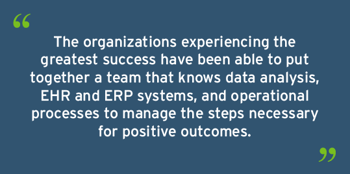Think back to 2009. One decade ago. What did your IT environment look like? Were you preparing for the daunting task of digitizing your entire organization and talking about CPOE? Were you living on a recently live EHR and trying to figure out how to measure the value of tackling system improvements while keeping the lights on? Or were you already rolling out your technologies across the organization or acquiring a larger footprint? 
Looking forward to the year ahead, your priorities probably look different. You might be looking for ways to gather insights to better optimize your system, or you could be integrating new technologies and turning your attention to other systems, like your ERP.
Today, I'd like to highlight four areas organizations have told us are top-of-mind for 2019 – ways they plan to use their systems to streamline, optimize, and support their goals of delivering better patient outcomes. If you’d like to discuss these or any other top priorities, and you’ll be attending HIMSS next month, please visit us at booth #2579.
Or, join us at our HIMSS19 reception on Monday, Feb. 11, from 6:30 – 9:30 p.m. at the Oceanaire Seafood Room. We’d love to listen to your organization’s priorities for 2019 and determine how best we can help you reach your goals.
1. Using EHR data to measure and manage a provider happiness program
The EHR is often cited as one of the main contributors to physician burnout. And we understand why. With the average primary physician spending more time working in the EHR on a daily basis than working face-to-face with patients, according to a study published in Family Medicine, it’s become a major rallying point for physician dissatisfaction industry-wide.
We’ll continue to see an increase in initiatives and resources that support organizations and their efforts to improve provider satisfaction. For example, last year, KLAS launched the Arch Collaborative, a provider-led effort to improve EHR usability and satisfaction through consistent measurement, benchmarking, and collaboration around best practices. The Arch Collaborative offers organizations the opportunity to measure feedback of their users and benchmark against other participating organizations.
Nordic is one of three consulting firms participating in the collaborative. We joined in August 2018 and have already leveraged Arch Collaborative’s research to help organizations improve physician satisfaction and get the most return from their EHR investment. We look forward to continuing to leverage this knowledge in 2019.
With the KLAS Arch Collaborative measuring and benchmarking physician happiness, and EHR vendors like Epic and Cerner offering system diagnostic tools to better view provider usage data, organizations have the tools to take a more scientific approach to addressing physician satisfaction. Organizations can now see the effects of building better workflows and simplified user interfaces that meet the needs of their providers, creating additional specialty content and providing mastery training for struggling users.
With a little bit of preparation, trainers can implement a much more tailored and interactive approach to optimization training. We believe the most effective physician happiness programs are those that focus separate efforts on three areas: provider mastery training, provider system-use improvements, and operational metrics (like third next-available appointments and patient throughput).
For example, Allina Health, a premiere not-for-profit healthcare system based in Minneapolis, recently used EHR data to improve its system and guide its training program. We partnered with Allina to build a customized dashboard that helped them view and analyze their end-user data trends. The dashboard informed enhancements to their system and helped them identify providers who were struggling with certain workflows – areas their performance support trainers could focus on during training.
Upon implementing this data-driven training method, the organization immediately began to see improved provider efficiency. Some providers at Allina have saved up to 3.6 minutes per patient (depending on the patient’s complexity). With each provider seeing upwards of 24 patients a day, the time savings is huge, and it makes a big difference in the lives of their providers and clinicians.
2. Getting more out of technical systems and infrastructure
With many other competing priorities, it’s hard to keep every part of every system in tip-top shape. Much like my own New Year’s resolution to lose a few pounds, it’s possible some of your systems have gotten a bit out of shape. Don’t worry, you’re not alone. Just like an influx of gym-goers in January, we’re seeing a lot of organizations turning their attention to the health of their systems.
Organizations will make it a priority to get their ERPs to be more current and useful. Much like the “Integrated vs. Best of Breed” conversation around EHRs, organizations are evaluating their ERP environment and making changes to meet their needs. Most of the ERP offerings are also moving to the cloud, leading organizations to explore taking on larger projects that encompass migrating their ERP and integrating with their other systems like their EHRs.
Speaking of, by better integrating EHR and ERP systems, organizations can experience some major cost reduction. One area where this is very apparent is in the OR. In fact, this was a main discussion topic among perioperative leaders at the 2018 OR Manager Conference. OR leaders shared that the integration between their EHR and ERP systems is a top priority in 2019. This integration helps optimize the critical relationship between preference cards and materials management. Room setup, turnover times, documentation efficiency, costs, charges, and patient safety all depend on the accuracy of these two elements.
We’re also seeing some deeper analysis and system cleanup to aid in reduced maintenance time and other cost savings. For example, it’s beneficial to do some analysis of your preference cards in the OR to see if there’s room for improvement. Small changes to preference card maintenance can lead to a large reduction in supply waste, costs, and turnover times. In addition, we’re witnessing an increased focus on looking at the system “lists” that, unencumbered, tend to grow over time (i.e., Lab Result Components and Interface Error Queues) and areas of confusion the lack standardization like Chart Review, User Security, System Access, and Workflow Engine templates.
3. Developing a data strategy and incorporating actionable AI
Data that provide the types of insights required to make meaningful change come from many of sources – patient data, personnel and ERP data, as well as external data, like claims data and care gaps. It can be challenging for organizations to get all that data in one place.
And while organizations are busy with systems clean up and integration this year, they’ll also continue to focus on getting clean, well-understood data management systems. By this point, most organizations have some sort of data warehouse and data analytics infrastructure in place. Now they’re shoring up their data governance, so they can layer on more advanced analytics. Organizations must be careful to address the source systems to ensure that there’s clean data coming in or they’ll be doing manual cleanup monthly in perpetuity.
Many groups are well down the path in targeted areas, such as identifying at-risk patients. For example, users are seeing artificial intelligence (AI) embedded in workflows to call attention to potentially changing patient health, acuity, readmission risk, etc. The algorithms in the background are complex, and the data is difficult to manage, but by layering advanced analytics on top of the technologies that they already have, it’s starting to look really simple for end-users. This has long been the promise of expensive EHRs and we’re finally seeing it in action. And what’s surprising is how quietly it becomes a seamless part of the user experience.
4. Managing value-based reimbursement priorities
Value-based reimbursement will remain top-of-mind for organizations in 2019. Payers, both public and private, will continue asking health systems to take on more responsibility for holding down healthcare costs through shared savings and shared loss arrangements (risk-based contracts). Many organizations are leveraging improved clinical workflows and better data to drive cost control, quality measure score increases, and complete chronic condition documentation, which will help organizations to manage the risk associated with these new payment arrangements. These organizations use systems like Epic’s Healthy Planet or Cerner’s Healthy Intent to forecast and manage the health needs of their patient populations and provide better care.
Other organizations have found it challenging to manage risk-based contracts. Some contributing factors we have seen include difficulty forecasting financial results due to a lack of good data or lack of analytical systems and expertise to properly analyze the data on hand. Value-based reimbursement can be challenging to navigate because it takes many different types of expertise. The organizations experiencing the greatest success have been able to put together a team that knows data analysis, EHR and ERP systems, and operational processes to manage the steps necessary for positive outcomes.
 To add another layer, in August 2018, CMS unveiled its proposed “Pathways to Success” program – an overhaul of the existing Medicare Shared Savings Program (MSSP), which would redesign participation options for Accountable Care Organizations (ACOs). Our optimization team discussed this topic on a recent episode of Nordic’s HIT Breakdown podcast, sharing what this proposed program means for ACOs and the changes they can anticipate in value-based care reimbursement.
To add another layer, in August 2018, CMS unveiled its proposed “Pathways to Success” program – an overhaul of the existing Medicare Shared Savings Program (MSSP), which would redesign participation options for Accountable Care Organizations (ACOs). Our optimization team discussed this topic on a recent episode of Nordic’s HIT Breakdown podcast, sharing what this proposed program means for ACOs and the changes they can anticipate in value-based care reimbursement.
No matter where you are with your value-based reimbursement strategy, Nordic can partner with you to help navigate this complex process. Please reach out and we can discuss your value-based reimbursement goals, including priorities outlined above, or other challenges your organization is facing this year.
And once again, if you’re heading to Orlando for HIMSS19 we’d love to chat. Please stop by booth #2579 or join us at our reception on Monday, Feb. 11, from 6:30 – 9:30 p.m. at the Oceanaire Seafood Room. We can discuss your priorities for the year over a custom cocktail and some fresh seafood.
Matt Schaefer is the executive VP of Strategic Services. He oversees Nordic’s strategic services and has nearly a decade of experience leading major healthcare IT projects. He continues to help health systems drive innovation with his growing team of experienced healthcare thought leaders. In seven years at Epic, he was an implementation executive on many large implementations and also served as primary Epic contact and strategic advisor for the C-suite at a number of clients. In 2014, he began working at Forte Research Systems as the VP of client experience, helping healthcare organizations manage their clinical trials portfolios. Matt holds a number of Epic certifications.






